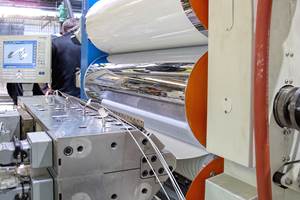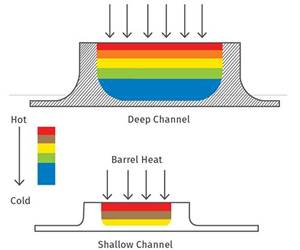Novel Profile Cooling Technology Promises Big Output Boost
Aimed at complex profiles such as PVC lineals, retrofittable system adds turbulent cooling to calibrator to boost output by 25-50%.
Patented technology aimed specifically at processors of complex profiles such as PVC window lineals promises to boost output rates by 25-50% by increasing cooling in the calibrators. Its inventor, consultant Randy Brown of , Maineville, Ohio, used the cooling technology at his own custom profile extrusion ┤¾¤¾┤½├¢ in the early 1990s.
Brown is making the invention, which he calls Innovative Cooling Technology (ICT), available commercially. Deploying the technology requires processors to modify existing calibration tools to direct turbulent water to hard-to-reach areas in the profile.
While PVC window profiles such as sashes, frames, main frames and other components are initial targets, Brown notes the technology can be applied to other crystalline or semi-crystalline thermoplastics that are difficult to extrude into a complex profile because of shrinkage.
“In fact, when I developed the concept for my ┤¾¤¾┤½├¢, I was trying to make more complicated profiles from polyethylene and polypropylene,” Brown says. “But these materials shrink so much that it was a bear to try to extrude them into a complex shape. So I came up with this system to help me out.”

New cooling technology from IPPI targets complex PVC window profiles although it also can be used on other thermoplastics. Source: Plastics Technology
By Brown’s estimation, output rates on at least 80% of complex profiles are limited by cooling capacity. He elaborates: “And the real problem is getting uniform cooling into the many channels and complex features of the profile, such as where a glazing bead with fit. Since cooling is time dependent, higher output rates require longer calibrator lengths, which increase cost and drag on the system proportional to the length of the calibrator.”
To this point, Brown says profile processors looking to add capacity have had to either add an altogether new line, utilize multistrand die technology on an existing line, switch to longer calibrators or employ stronger pullers. All these options require significant capital investment. What’s more, longer calibrators tend to result in higher drag while stronger pullers can induce higher residual stresses on the part.
How ICT Boosts Output
“Tool builders for complex window profiles basically make their tools the same way: using steel to hold the part to shape until all parts of the profile cool to below the glass-transition temperature of the polymer,” Brown says. “They do this because this system works. But ICT takes a different approach to cooling the complex shape. Current calibration technology relies completely on conduction, where heat is transferred from the plastic to the metal of calibrator, usually in an uneven manner. ICT, on the other hand, combines both conduction and convection to make cooling more efficient, so the profile cools more uniformly. So rather than using steel to hold the part to shape until it cools, the new approach engineers the calibrator to cool the part uniformly, even in the channels and other complex details of the profile.”
Typical window profile lines have up to five calibrators, each of which is about 1-ft long. Brown claims that modifying the last four calibrators with ICT will boost output by at least 25%. ICT requires nothing in the way of “exotic” cooling media such as nitrogen — it needs only existing chilled water — and requires no additional operating or capital costs, he adds.

Typical calibration tools rely on conduction to transfer heat from the polymer to the steel. Often this heat transfer is irregular and restricts output as a result.
Source: IPPI

With ICT technology, cooling channels are machined and turbulent water is directed to difficult-to-reach areas of the profile. More efficient cooling enables faster line speeds.
Source: IPPI
To do ┤¾¤¾┤½├¢ with Brown, processors need to provide one tool along with a history of performance (line speed, yield, etc.). IPPI will then retrofit the tool with ICT and trial it for performance, comparing those results with what the processor had been getting from the previous design. As Brown notes, most processors of complex profile extrusions have their own machine shops and build or modify tools on their own. In an ideal scenario, he’d work with a processor with in-house tooling capabilities.
But Brown says he’s willing to work with outside machine shops as well. With his system, he says that new tools can be built at no additional cost while existing tools can be modified at a cost of roughly $2,000/tool.
As Brown explains, the higher output rates made possible by ICT mean that a tool that is currently run for 40 hours per month could achieve the same output of product in 30 hours. “What is an hour of machine time worth to a typical extrusion ┤¾¤¾┤½├¢? When spread across all viable tools, the capacity of that operation could be increased by 20-25% without any capital expenditures,” he says. Brown also seen faster start-ups and higher yields, but those tend to be harder to quantify because they are very dependent on the particular operation.
Related Content
Part 2 Medical Tubing: Use Simulation to Troubleshoot, Optimize Processing & Dies
Simulation can determine whether a die has regions of low shear rate and shear stress on the metal surface where the polymer would ultimately degrade, and can help processors design dies better suited for their projects.
Read MoreRoll Cooling: Understand the Three Heat-Transfer Processes
Designing cooling rolls is complex, tedious and requires a lot of inputs. Getting it wrong may have a dramatic impact on productivity.
Read MoreNPE2024 Wrap-Up: Sustainability Dominates Show Floor News
Across all process types, sustainability was a big theme at NPE2024. But there was plenty to see in automation and artificial intelligence as well.
Read MoreThe Importance of Barrel Heat and Melt Temperature
Barrel temperature may impact melting in the case of very small extruders running very slowly. Otherwise, melting is mainly the result of shear heating of the polymer.
Read MoreRead Next
Making the Circular Economy a Reality
Driven by brand owner demands and new worldwide legislation, the entire supply chain is working toward the shift to circularity, with some evidence the circular economy has already begun.
Read MoreFor PLASTICS' CEO Seaholm, NPE to Shine Light on Sustainability Successes
With advocacy, communication and sustainability as three main pillars, Seaholm leads a trade association to NPE that ‘is more active today than we have ever been.’
Read More











